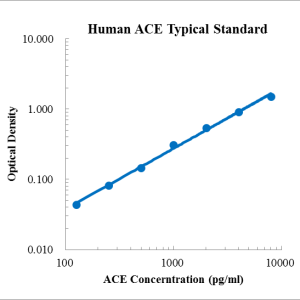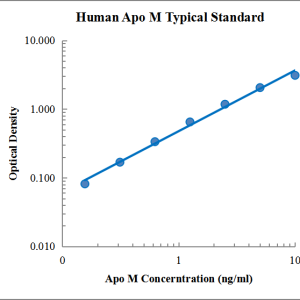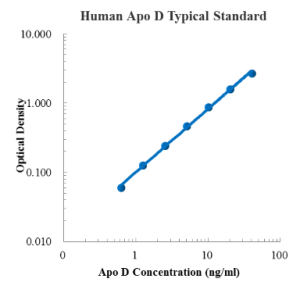Human CXCL3/GRO-γ ELISA Kit
$299.00 – $419.00
ELISA Kit Detail Information
| Related Target | |
|---|---|
| Species | human |
| Sample Type | Serum, plasma, cell culture supernatant, and other biological samples |
| Sample Volume | 100 μL (diluent) |
| Sensitivity | 0.24 pg/mL |
| Array Range | 1.56 pg/mL – 100 pg/mL |
| Assay Time | 3.5 h |
| Recovery | 86% – 105% |
| Average Recovery | 95% |
| Intra Precision | 2.6% – 5.5% |
| Inter Precision | 2.3% – 11.5% |
| Plate | Detachable 96-well plate |
| Storage | If the reagent kit is unopened, it should be stored at 4℃. However, if it has been opened, the standard solution should be stored at -20℃, while the other components should be stored at 4℃. |
| Delivery | 4℃ blue ice transportation |
| Components | 96-well polystyrene enzyme-linked immunosorbent assay (ELISA) plate coated with anti-CXCL3/GRO-γ monoclonal antibody Human CXCL3/GRO-γ freeze-dried standard Angiotensinogen/AGT/ SerpinA8 detect Antibody Standard Diluent Assay Buffer(10×) Substrate TMB Stop Solution Washing Buffer(20×) Sealing Film |
| Assay Principle | This kit utilizes the double antibody sandwich enzyme-linked immunosorbent assay (ELISA) detection technique.Specific anti-human CXCL3 antibodies are precoated on a high-affinity ELISA plate.Standards and test samples are added to the wells of the ELISA plate. After incubation, the CXCL3 present in the samples binds to the solid-phase antibodies. After washing to remove unbound substances, biotinylated detection antibodies are added and incubated. After washing to remove unbound biotinylated antibodies, streptavidin-HRP labeled with horseradish peroxidase is added. After washing, a colorimetric substrate, TMB, is added and the plate is incubated in the dark for color development. The intensity of the color reaction is directly proportional to the concentration of CXCL3 in the samples.A stop solution is added to terminate the reaction, and the absorbance value is measured at a wavelength of 450 nm (with a reference wavelength range of 570-630 nm). |
Related Targets
CXCL3
CXCL3 Target Infomation Overview
- Target Symbol: CXCL3, C-X-C motif chemokine ligand 3
- Gene Groups: Chemokine ligands
- Alias: SCYB3; GROg; MIP-2b; CINC-2b
- Previous Names: GRO3
- Alias Names: GRO3 oncogene; chemokine (C-X-C motif) ligand 3
CXCL3, C-X-C motif chemokine ligand 3 Target Infomation by Species
- Human
- Mouse
- Rat
Human CXCL3 Target Information
- Target Symbol: CXCL3, C-X-C motif chemokine ligand 3
- Alias:
- C-X-C motif chemokine 3
- chemokine (C-X-C motif) ligand 3
- CINC-2b
- GRO-gamma
- GRO-gamma(1-73)
- GRO3
- GRO3 oncogene
- GROg
- growth-regulated protein gamma
- macrophage inflammatory protein 2-beta
- melanoma growth stimulatory activity gamma
- MGSA gamma
- MIP-2b
- MIP2-beta
- MIP2B
- SCYB3
- NCBI_Gene: 2921
- UniProtKB: P19876
Human CXCL3 Predicted Functions
Predicted to enable CXCR chemokine receptor binding activity and chemokine activity. Involved in antimicrobial humoral immune response mediated by antimicrobial peptide and killing of cells of other organism. Located in extracellular space.
Mouse Cxcl3 Target Information
- Target Symbol: Cxcl3, chemokine (C-X-C motif) ligand 3
- Alias:
- Dcip1
- gene model 1960, (NCBI)
- Gm1960
- NCBI_Gene: 330122
Mouse Cxcl3 Predicted Functions
Enables chemokine activity. Involved in neutrophil chemotaxis. Predicted to be located in extracellular region. Predicted to be active in extracellular space. Is expressed in genitourinary system; gut; and thymus. Orthologous to human CXCL1 (C-X-C motif chemokine ligand 1); CXCL2 (C-X-C motif chemokine ligand 2); and CXCL3 (C-X-C motif chemokine ligand 3).
Rat Cxcl3 Target Information
- Target Symbol: Cxcl3, C-X-C motif chemokine ligand 3
- Alias:
- C-X-C motif chemokine 3
- chemokine (C-X-C motif) ligand 3
- Cinc-2
- Cinc2
- cytokine-induced neutrophil chemoattractant 2
- cytokine-induced neutrophil chemoattractant-2
- gene model 1960, (NCBI)
- Gm1960
- macrophage inflammatory protein 2-alpha/beta
- MIP2-alpha/beta
- NCBI_Gene: 171551
- UniProtKB: Q10746
Rat Cxcl3 Predicted Functions
Enables chemokine activity. Involved in several processes, including cellular response to lipopolysaccharide; neutrophil chemotaxis; and positive regulation of cytosolic calcium ion concentration. Located in extracellular space. Biomarker of Coronavirus infectious disease and bacterial pneumonia. Orthologous to human CXCL1 (C-X-C motif chemokine ligand 1); CXCL2 (C-X-C motif chemokine ligand 2); and CXCL3 (C-X-C motif chemokine ligand 3).














Reviews
There are no reviews yet.